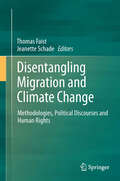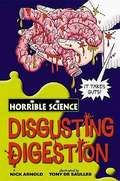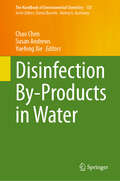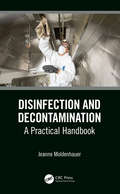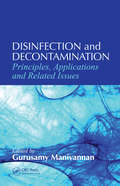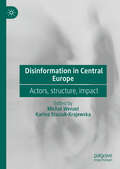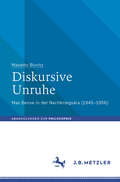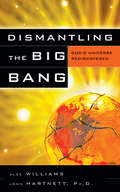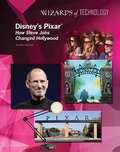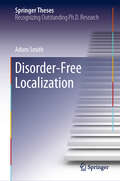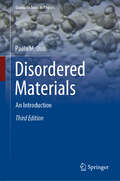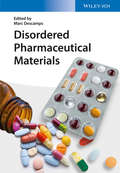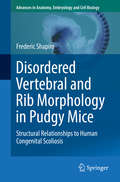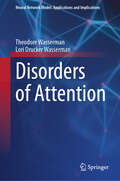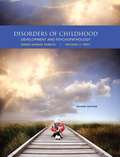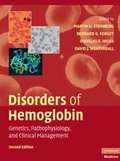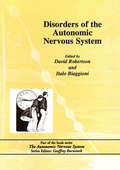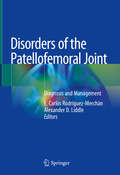- Table View
- List View
Disentangling Migration and Climate Change: Methodologies, Political Discourses and Human Rights
by Thomas Faist Jeanette SchadeThis book addresses environmental and climate change induced migration from the vantage point of migration studies, offering a broad spectrum of approaches for considering the environment/climate/migration nexus. Research on the subject is still frequently narrowed down to climate change vulnerability and the environmental push factor. The book establishes the interconnections between societal and environmental vulnerability, and migration and capability, allowing appreciation of migration in the frame of climate as a case of spatial and social mobility, that is, as a strategy of persons and groups to deal with a grossly unequal distribution of life chances across the world. In their introduction, the editors fan out the current debate and state the need to transcend predominantly policy-oriented approaches to migration. The first section of the volume focuses on "Methodologies and Methods" and presents very distinct approaches to think climate induced migration. Subsequent chapters explore the sensitivity of existing migration flows to climate change in Ghana and Bangladesh, the complex relationship between migration, demographic change and coping capacities in Canada, methodological challenges of a household survey on the significance of migration and remittances for adaptation in the Hindu Kush region and an econometric study of the aftermath of the 1998 floods in Bangladesh. The second part, "Areas of Concern: Politics and Human Rights", deepens the analysis of discourses as well as of the implications of proposed and implemented policies. Contributors discuss such topics as environmental migration as a multi-causal problem, climate migration as a consequence in an alarmist discourse and climate migration as a solution. A study of an integrated relocation program in Papua New Guinea is followed by chapters on the promise and the flaws of planned relocation policy, global policy on protection of environmental migrants including both internally displaced peoples and those who cross international borders. A concluding chapter places human agency at centre stage and explores the interplay between human rights, capability and migration.
Disgusting Digestion
by Nick Arnold Tony De SaullesScience with the squishy bits left in! What disease makes your eyes bleed? Why can't astronauts eat beans before a space flight? Which part of your brain makes you throw up? Get the awful answers in Disgusting Digestion
Disgustology: The Science of Gross
by Teresa RobesonPerfect for middle schoolers who love everything gross from the nasty things inside (and out) of our bodies to icky animals, revolting plants, gruesome bacteria, and more. Written by award-winning author Teresa Robeson, this book is packed full of fun facts and silly science, along with truly eye-popping illustrations and photographs that make intestines, boogers, ringworms, fecal coliforms, and brain eating amoeba even more vivid and visceral. Readers will be gagging and giggling at the same time. It's truly the most disgusting book ever!
Disinfection By-Products in Water (The Handbook of Environmental Chemistry #135)
by Chao Chen Yuefeng Xie Susan AndrewsThis book offers a comprehensive review of disinfection by-products (DBPs), exploring various aspects from detection methods and precursors to their potential health risks, regulation, and future implications. This book is also a memorial to the 50th anniversary of the first major DBP report in 1974 by Dr. Rook, who identified chloroform in chlorinated drinking water, initiating the study of DBPs. For half a century, chemists, toxicologists, engineers and regulators have been identifying more DBPs, understanding their formation mechanism, evaluating their health effects on the public, and minimizing and controlling their formation in drinking water. Divided into four parts, the book commences with an introduction to the general knowledge of DBPs, shedding light on the significance of DBPs and their impact on water quality. It also delves into the detection methods employed to identify and quantify DBPs, offering readers invaluable insights into cutting-edge techniques and emerging technologies, and explores the sources and characteristics of DBP precursors. In Part II, several expert contributors provide an overview of individual DBPs, including halogenated aliphatic, iodinated, aromatic, and heterocyclic DBPs, discussing their properties and potential implications. The discussion extends to nitrogenous DBPs, the group of nitrosamines, and inorganic DBPs as well. Part III provides an authoritative perspective on the relationship between energy consumption, climate change, and DBP formation, offering also insights into DBPs in the context of water treatment plants, water reuse plants, swimming pools, and everyday life. The book closes with a section devoted to the health effects of DBPs, where particular attention is given to the analysis of the toxicity and health risks associated with DBPs. In this section, readers will find more about the potential adverse effects of DBPs on human health and current research on risk assessment and management strategies. In today's era of water scarcity and increasing demands for safe drinking water, the presence of DBPs has emerged as a critical concern in the field of public health. This book is, therefore, an invaluable resource for researchers, water treatment professionals, public health officials, and policymakers seeking a comprehensive understanding of DBPs.
Disinfection and Decontamination: A Practical Handbook
by Jeanne MoldenhauerThis book describes various methods of decontamination and how the methods work. There is a discussion of the various cleaning and disinfection methods utilized, along with details of how to qualify these methods. It also describes new technologies that may be useful in the battle for decontamination across industries. Finally, this book provides a single resource on how one can address contamination issues for a variety of manufacturing processes and industries. Explores new technologies that may be useful in the battle for decontamination Examines various methods of decontamination and how the methods work Addresses contamination issues for a variety of manufacturing processes and industries Describes how to detect contaminants as well as how to deal with contaminants that are present Includes methods for both decontamination (reaction) and preventing contamination (proactive)
Disinfection and Decontamination: Principles, Applications and Related Issues
by Gurusamy ManivannanIn the battle between humans and microbes, knowledge may be not only the best weapon but also the best defense. Pulling contributions from 34 experts into a unified presentation, Disinfection and Decontamination: Principles, Applications, and Related Issues provides coverage that is both sophisticated and practical. The book reviews the fund
Disinformation in Central Europe: Actors, structure, impact
by Michał Wenzel Karina Stasiuk-KrajewskaThis book presents different approaches to disinformation based on original data from quantitative and qualitative studies conducted within CEDMO (Central European Digital Media Observatory). The linguistic and visual features of this type of communication are analyzed in the context of the discursive and genre framing of fake news. The authors discuss the psychological mechanisms of the reception of manipulated content, as well as the legal and political contexts of disinformation in Central Europe (Poland, the Czech Republic, Slovakia). The book presents the results of comparative research on attitudes to Covid-19 and the war in Ukraine, linking the two. The volume contains not only empirical studies, but also an elaborate proposal for a theoretical approach to manipulated content and a coherent methodological model that can be used to deepen scientific knowledge of this complex area of study.
Diskursive Unruhe: Max Bense in der Nachkriegsära (1945–1956) (Abhandlungen zur Philosophie)
by Masetto BonitzMax Bense (1910–1990) suchte in der Nachkriegsära entschieden die Öffentlichkeit. Er war Diskursträger und eine Persönlichkeit, die polarisierte. Dennoch geriet er in eine offensichtlich merkwürdige Vergessenheit, die seinem Werk, seiner Persönlichkeit und der geschichtlichen Entwicklung nicht gerecht wird. Dieses Buch befasst sich eingehend mit dem im Deutschen Literaturarchiv Marbach liegenden Nachlass Max Benses und fokussiert insbesondere auf den Briefeschreiber und -empfänger in der Nachkriegsära (1945–1956). Dabei wird sichtbar, was in dieser Zeit kulturpolitisch als auch geistesgeschichtlich verhandelt wurde und was für deutsche Gelehrte, Intellektuelle und Schriftsteller auf dem Spiel stand. Bense agierte in Diskursen der Philosophie, Literatur, Kunst und Politik, wobei er gegen erhärtete Machtstrukturen vorging und seine Umwelt beunruhigte. Er verfasste eine Vielzahl kritischer Beiträge für Zeitungen, Zeitschriften und Sammelbände, die symptomatisch für die Nachkriegszeit waren. Sie transportieren dabei oftmals politische Dimensionen, durch die Stimmungen der frühen Nachkriegsjahre und der Adenauerzeit sichtbar werden.
Dismantling the Big Bang: God's Universe Rediscovered
by Alexander Williams Dr John HartnettWhy did Ptolemy's theory cause problems for the church? What is the big secret concerning the "?Age" of the earth? Why do many scientists reject the use of design in explaining origins? The seemingly absurd idea that all matter, energy, space, and time once exploded from a point of extreme density has captured the imagination of scientists and laypersons for decades. The big bang has provided a central teaching for the eons of time of "cosmic evolution", undermining the history and cosmology of the Bible. It is a theory that fails, even violating the very physical laws on which it is purportedly based.In this easy-to-read format, authors Alex Williams and John Hartnett explode this naturalistic explanation for the universe, and show that the biblical model provides a far better explanation of our origins. This fully indexed, illustrated analysis of the big bang theory is an invaluable help in understanding and countering a world view that is as chaotic and destructive as its name implies.
Disney's Pixar®: How Steve Jobs Changed Hollywood
by Aurelia JacksonPixar is one of the most successful companies creating movies today. You've probably seen at least one of their huge hits, movies such as Toy Story, Monsters, Inc., Cars, or Wall*E. Ever since Steve Jobs, founder of Apple Computers, bought the company from George Lucas, creator of Star Wars, Pixar has changed the way animated movies are made. Steve has turned the company into something incredible. Discover the story of how Steve gave Pixar the chance to make their first movies, how Pixar changed Hollywood--and how Pixar hopes to keep on amazing moviegoers in the future.
Disorder-Free Localization (Springer Theses)
by Adam SmithThis thesis is a contribution at the intersection of a number of active fields in theoretical and experimental condensed matter, particularly those concerned with disordered systems, integrable models, lattice gauge theories, and non-equilibrium quantum dynamics. It contributes an important new facet to our understanding of relaxation in isolated quantum systems by conclusively demonstrating localization without disorder for the first time, answering a long-standing question in this field. This is achieved by introducing a family of models – intimately related to paradigmatic condensed matter models – and studying their non-equilibrium dynamics through a combination of exact analytical mappings and an array of numerical techniques. This thesis also makes contributions relevant to the theory of quantum chaotic behaviour by calculating novel, and often intractable, entanglement measures and out-of-time-ordered correlators. A concrete and feasible proposal is also made for the experimental realization and dynamical study of the family of models, based on currently available technologies.
Disordered Materials: An Introduction (Graduate Texts in Physics)
by Paolo M. OssiThis self-contained textbook takes readers on a comprehensive journey through the intricate realm of physics in structurally disordered condensed materials. Tailored for advanced undergraduate and graduate students, this book unfolds the complexities step by step. In this updated and enlarged 3rd edition, fundamental building blocks serve as the foundation for constructing structural models of disordered solids, delving into their geometry and symmetry. The scope of the book encompasses the phenomenology and various models of the glass transition, elucidating the characteristics of bulk metallic glasses. Structural analysis techniques for amorphous solids, the role of atomic clusters in structure evolution, quasicrystals, nanometer-sized disordered solids, cluster-assembled materials, and the synthesis and assembly of nanoparticles are explored. The text also navigates through the intricacies of transport and localization in heavily disordered materials, offering insights into controlled growth of thin films. Throughout, the narrative is enriched with references to recent and pertinent results, both experimental and theoretical, providing readers with a gateway to the latest and most dynamic research areas in the field.
Disordered Pharmaceutical Materials
by Marc DescampsA one-stop resource for researchers and developers, this handbook and ready reference provides detailed, but not overloaded information -- presenting the topic without unnecessarily complex formalism. As such, it gives a systematic and coherent overview of disordered materials for pharmaceutical applications, covering fundamental aspects, preparation and characterization techniques as well as molecular modeling approaches for the target-oriented development of drug delivery systems based on amorphous solids. Chapters on the challenges of using these materials in large-scale processes in the pharmaceutical industry and on patenting issues round off the book. For pharmaceutical and medicinal chemists, materials scientists, clinical physicists, and pharmaceutical laboratories looking to make better and more potent pharmaceuticals.
Disordered Vertebral and Rib Morphology in Pudgy Mice
by Frederic ShapiroThis book presents results obtained from the whole mount preparations, radiological, and histological studies of 60 pu/pu and pu/+ mice from late embryo until 3 months of age. Most mice were in the embryo to 6 week age group where vertebral developmental changes are most marked. Although vertebral abnormalities have been identified as due to mutations in the delta-like 3 (Dll3) gene, it is evident that each mouse has differing structural abnormalities. The disorder is analogous to human congenital scoliosis, a common variant of which is spondylocostal dysplasia. The histological studies presented in this book include plastic embedded sections which allow for high level resolution not only of vertebrae, intervertebral discs, and ribs but also of associated spinal cord, nerve roots and ganglia. In addition an overview of embryo and neonatal development in mouse, chick and human vertebrae is provided to better assess how and where deviant pathoanatomy occurs. The book discusses the possible variables involved in creating final deformity beyond the gene abnormality itself.
Disorders of Attention (Neural Network Model: Applications and Implications)
by Lori Drucker Wasserman Theodore WassermanThis is the fourth book in the Neural Network series. It proposes an entirely new model for assessing and understanding how issues with attention are manifested. Currently, most individuals with deficit in attentional functioning are labeled with attention deficit hyperactivity disorder. This is because the current nosology is behaviorally driven and the target behavior for attention deficit hyperactivity disorder is the end stage global behavior, attention. The use of this nosology results in a large number of related but neuroanatomically different issues, from a neural network perspective, being lumped together. This results in a homogenous approach to the treatment of a heterogeneous cluster of problems and impedes research into the actual underlying network properties of specific forms of attentional problems. This book reviews and summarizes the current cognitive neuroscience regarding how attention is regulated in the human brain. It then details the various networks and processes that comprise attention and for each of these, details what could, and does, go wrong. This leads to a discussion of clinical assessment of these as yet unidentified “disorders” and recommendations for research and treatment. The book also has sections on the cognitive neuroscience of attention, models of attentional processing, a description of the neural networks involved in attention and a discussion of specific problems that arise when these network components fail to do their job correctly. The result of this work is a complete reformulation of the existing construct of attention deficit hyperactivity disorder which, in its current form, represents a plethora of disruptions of a multitude of attentional processes. The work challenges existing conceptual modeling and offers a new model for diagnosis and treatment, continuing to extend the authors’ work in blending clinical neuroscience into the clinical practice of neuropsychology.
Disorders of Childhood: Development and Psychopathology
by Robin Hornik Parritz Michael F. TroyWritten with the whole child in mind, this book discusses disorders in connection with the different stages of development, providing both a meaningful framework to promote learning. The authors emphasize multi-factor explanations of disorders as well as developmental frameworks and developmental pathways--presenting disorders and sets of disorders in the order in which they typically appear in a child's life. They also focus on the child-in-context (calling attention to the multiple settings in which the child is embedded) and emphasize the importance of taking a broad view that considers the whole child and his or her patterns of interest, abilities, and strengths, rather than a narrow view of a disorder or developmental delay. As a result of this holistic approach, which reflects the most up-to-date understanding of child and adolescent psychopathology, readers learn to think about disorders in the same way that caring adults think about disorders they encounter every day--in terms of an individual child who is coping with distress and dysfunction. Available with InfoTrac Student Collections http://gocengage.com/infotrac.
Disorders of Hemoglobin: Genetics, Pathophysiology, and Clinical Management
by Martin H. Steinberg Bernard G. Forget Douglas R. Higgs David J. WeatherallThis book is a completely revised new edition of the definitive reference on disorders of hemoglobin. Authored by world-renowned experts, the book focuses on basic science aspects and clinical features of hemoglobinopathies, covering diagnosis, treatment, and future applications of current research. While the second edition continues to address the important molecular, cellular, and genetic components, coverage of clinical issues has been significantly expanded, and there is more practical emphasis on diagnosis and management throughout. The book opens with a review of the scientific underpinnings. Pathophysiology of common hemoglobin disorders is discussed next in an entirely new section devoted to vascular biology, the erythrocyte membrane, nitric oxide biology, and hemolysis. Four sections deal with α and β thalassemia, sickle cell disease, and related conditions, followed by special topics. The second edition concludes with current and developing approaches to treatment, incorporating new agents for iron chelation, methods to induce fetal hemoglobin production, novel treatment approaches, stem cell transplantation, and progress in gene therapy.
Disorders of the Autonomic Nervous System
by Alan S. RobertsonDisorders of the Autonomic Nervous System, the fifth volume in The Autonomic Nervous System book series, is a description of the disorders which give rise to autonomic failure and orthostatic hypotension. Each chapter is prepared by an international authority in the diagnosis and treatment of that disorder. The language and terminology are clear enough to promote understanding of the clinical problems and the underlying concepts of basic science. The most recent data, especially that derived from molecular biology, is included in the discussions of relevant diseases. Hence, the volume provides an unparalleled source of information about this area of medicine and will be helpful not just to practising clinicians but also to basic scientists researching in the field who need to familiarize themselves with the clinical problems.
Disorders of the Patellofemoral Joint: Diagnosis and Management
by E. Carlos Rodríguez-Merchán Alexander D. LiddleThis state-of-the-art book provides a comprehensive overview of the most common patellofemoral joint problems. Utilizing the latest evidence, it guides readers through prevention, diagnosis and treatment for both adult and paediatric patients. After discussing clinical examination and diagnosis, it explores topics such as acute and recurrent dislocation of the patella, cartilage defects of the joint, patellofemoral instability and patellofemoral osteoarthritis. The book also features a chapter on conservative strategies, including physical medicine and rehabilitation. Research is moving quickly in this field, and as such there is a growing need for consensus documents: written by leading experts, this comprehensive book is a valuable resource for orthopaedic surgeons, knee specialists and sports medicine ones, and is also of great interest to physiatrists, physical therapists and all healthcare workers involved in the care of these patients.
Dispatches from Planet 3: 32 (Brief) Tales on the Solar System, the Milky Way, and Beyond
by Marcia BartusiakAn award-winning science writer presents a captivating collection of cosmological essays for the armchair astronomerThe galaxy, the multiverse, and the history of astronomy are explored in this engaging compilation of cosmological tales by multiple-award-winning science writer Marcia Bartusiak. In thirty-two concise and engrossing essays, the author provides a deeper understanding of the nature of the universe and those who strive to uncover its mysteries.Bartusiak shares the back stories for many momentous astronomical discoveries, including the contributions of such pioneers as Beatrice Tinsley, with her groundbreaking research in galactic evolution, and Jocelyn Bell Burnell, the scientist who first discovered radio pulsars. An endlessly fascinating collection that you can dip into in any order, these pieces will transport you to ancient Mars, when water flowed freely across its surface; to the collision of two black holes, a cosmological event that released fifty times more energy than was radiating from every star in the universe; and to the beginning of time itself.
Dispatches from the Vaccine Wars: Fighting for Human Freedom During the Great Reset (Children’s Health Defense)
by Christopher A. ShawEnter the trenches of the bloodiest battles you've never heard of: the Vaccine Wars. Professor Christopher A Shaw discovered, after a deep-dive literature search on aluminum impacts on humans and animals, that aluminum hydroxide, an adjuvant in the anthrax vaccine, had a significantly negative impact on motor functions and reflexes of patients in the literature. After that finding, he did what scientists are supposed to do and kept following the leads. However, organizations like WHO dismissed him immediately. Those powerful organizations either knew what he knew, that aluminum vaccine adjuvants were harmful, or they simply didn&’t care. In either case, two possible reasons for the lack of response became clear to Shaw and his colleagues: dogma and money. The first had served to convince most of the world&’s medical professionals that Shaw had to be wrong because, after all, &“the science was settled.&” And, behind much of this was the naked fact of how much money vaccines brought in to cover the pharmaceutical industry&’s profit margin. The combination of those two have the finger prints of various Big Pharma companies smudged all over the question of vaccine safety, which included the demonization of both scientists and lay scholars who raised even the tamest questions about safety and the push for vaccine mandates around the world. After these events, Shaw decided to dig deeper.Dispatches from the Vaccine Wars is a comprehensive look at the origin of vaccination and the oversight of vaccines by various regulatory bodies in the United States and in Canada. The book provides not only the official view on vaccines safety and efficacy, but also provides a critical analysis on which such views are based. Aluminum and other compounds that may contribute to autism spectrum disorder are discussed at length. Professor Shaw also analyzes the corporate influences driving vaccine uptake worldwide and provides an in depth look at the push for mandatory vaccination. Dispatches from the Vaccine Wars evaluates the extent to which vaccinology has become a cult religion driving attempts to suppress divergent scientific opinions. Finally, the book delves into the COVID-19 pandemic and what it means for the future of us all.
Dispelling chemical industry myths (Chemical Engineering Ser.)
by Trevor A. KletzThis book covers myths about technology, management, toxicology, and the environment. It helps all who work in the chemical industry and all chemical engineers, including teachers and students to avoid accidents and wrong decisions and use resources more effectively.
Dispencing with the Truth: The Victims, the Drug Companies, and the Dramatic Story Behind the Battle Over Fen-Phen
by Alicia MundyIn 1996, a terrible epidemic began killing young American women. Some died quickly, literally dropping in their steps. Others took more time, from a few months to a few years. Those who weren't killed suffered damage to their lungs and hearts, much of it permanent and reparable only with major surgery. Doctors suspected what the killer was. So did the Food and Drug Administration. The culprits were the two most popular diet drugs in the United States, Pondimin, one-half of the popular drug combination Fen-Phen, and Redux, a stronger version of Pondimin. They were also two of the most profitable drugs on the market, and both were produced and sold by a powerful pharmaceutical company, Wyeth-Ayerst, a division of American Home Products. Dispensing the Truth is the gripping story of who really knew about the drugs, the ways they kept this information from the public, doctors, and FDA, and the massive legal battles that ensued as victims and their attorneys searched for the truth behind the debacle. It tells the story of a healthy young woman, Mary Linnen, who took the drugs for only twenty-three days to lose weight before her wedding, and then died in the arms of her fiance a few months later. Hers was the first wrongful-death suit filed and would become the most important single suit the company would ever face. Alicia Mundy provides a shocking and thoroughly riveting narrative. It is a stark look at the consequences of greed and a cautionary tale for the future.
Dispersal, Individual Movement and Spatial Ecology
by Philip K. Maini Mark A. Lewis Sergei V. PetrovskiiDispersal of plants and animals is one of the most fascinating subjects in ecology. It has long been recognized as an important factor affecting ecosystem dynamics. Dispersal is apparently a phenomenon of biological origin; however, because of its complexity, it cannot be studied comprehensively by biological methods alone. Deeper insights into dispersal properties and implications require interdisciplinary approaches involving biologists, ecologists and mathematicians. The purpose of this book is to provide a forum for researches with different backgrounds and expertise and to ensure further advances in the study of dispersal and spatial ecology. This book is unique in its attempt to give an overview of dispersal studies across different spatial scales, such as the scale of individual movement, the population scale and the scale of communities and ecosystems. It is written by top-level experts in the field of dispersal modeling and covers a wide range of problems ranging from the identification of Levy walks in animal movement to the implications of dispersal on an evolutionary timescale.
Dispersing Primate Females
by Takeshi Furuichi Juichi Yamagiwa Filippo AureliWhy do females in male-philopatric species seem to show larger variation in their life history strategies than males in female-philopatric species? Why did females in human societies come to show enormous variation in the patterns of marriage, residence and mating activities? To tackle these important questions, this book presents the latest knowledge about the dispersing females in male-philopatric non-human primates and in human societies. The non-human primates that are covered include muriquis, spider monkeys, woolly monkeys, gorillas, chimpanzees, bonobos and some species of colobine monkeys. In these non-human primate species females typically leave their natal group before sexual maturation and start reproduction in other groups into which they immigrate. However, there is a large variation as some females may breed in their natal group with some risks of inbreeding with their male relatives and some females may associate with males of multiple groups at the same time after leaving their natal group. Such variation seems to provide better strategies for reproduction depending on local circumstances. Although knowledge about female dispersal patterns and life history is indispensable for understanding the dynamic structure of primate societies, it is still not known how females behave after leaving their natal groups, how many groups they visit before finally settling down and which kinds of groups they choose to immigrate into, due to the large variation and flexibility and the difficulty of tracking females after natal dispersal. To encourage further progress in this important field, this volume provides new insights on evolution of female dispersal by describing factors influencing variations in the dispersal pattern across primates and a hypothesis for the formation of human families from the perspectives of female life history. This book is recommended reading for researchers and students in primatology, anthropology, animal behavior and evolution and for anyone interested in primate societies and human evolution.
